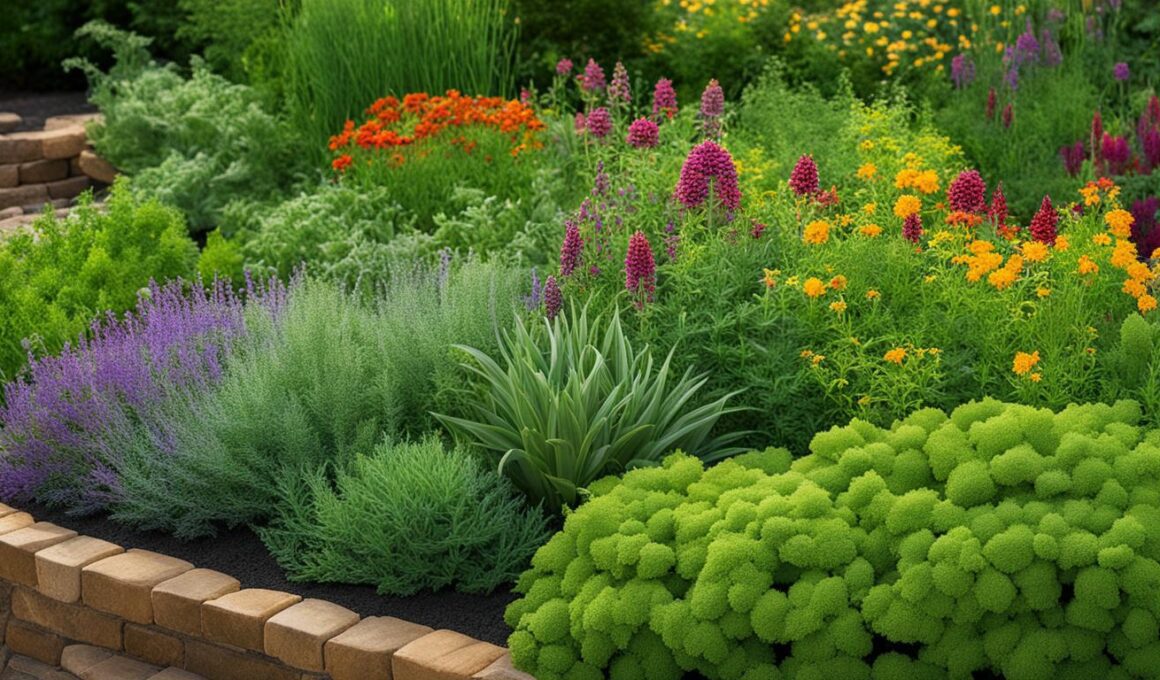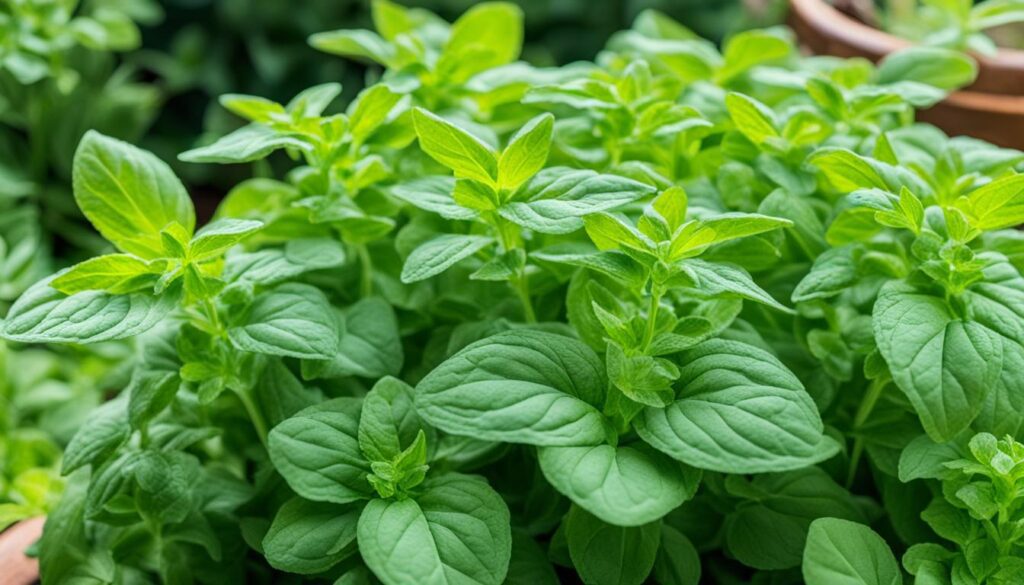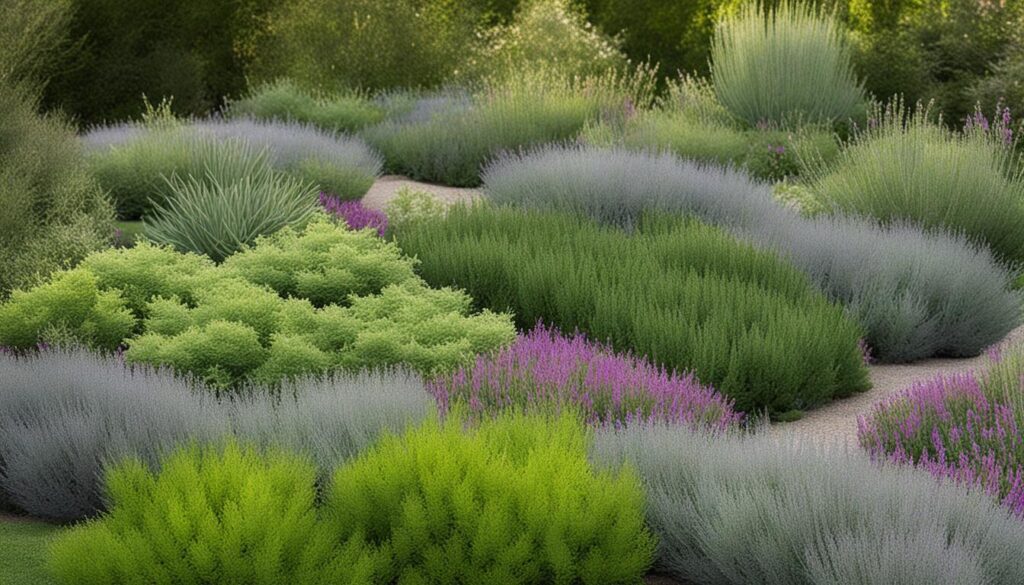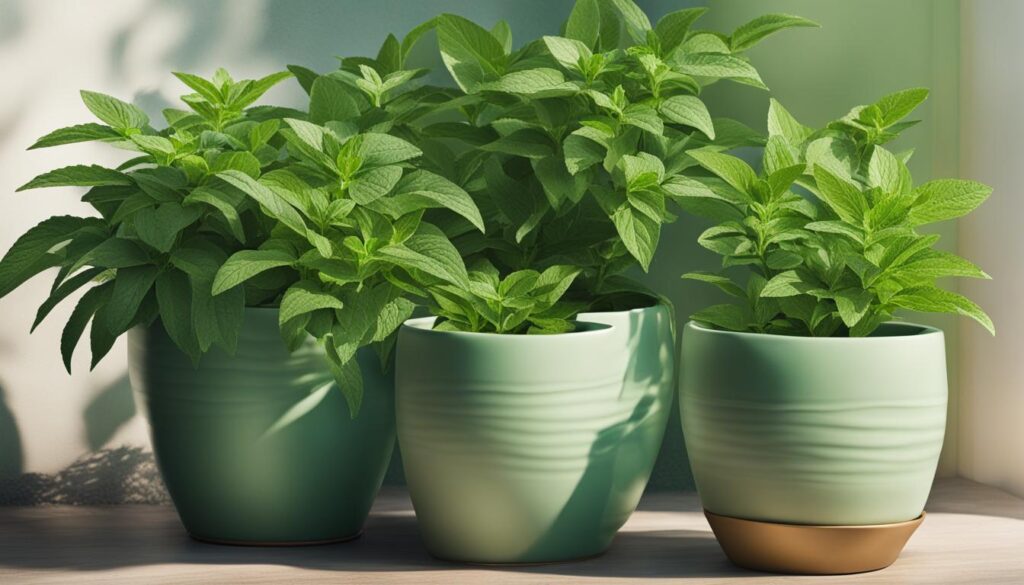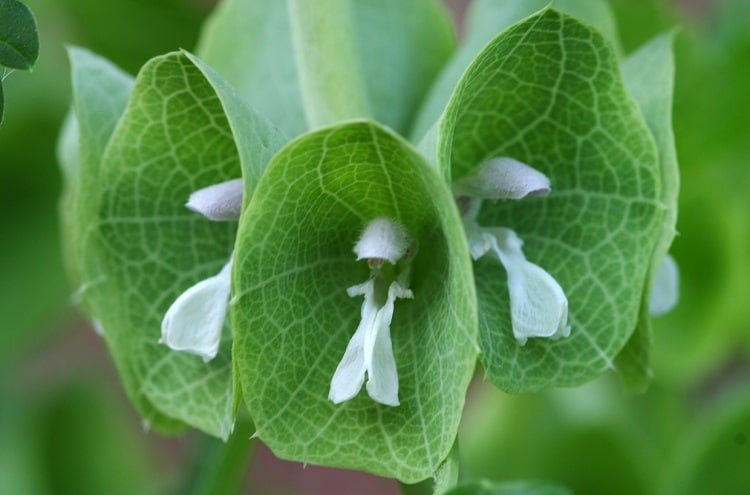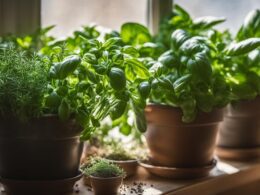Companion planting with herbs is a great way to maximize the potential of your garden. By planting certain herbs together, you can create a harmonious environment that benefits both the plants and your culinary endeavors. Here, we will explore some popular culinary herb combinations that work well together based on their flavor profiles and compatibility.
Key Takeaways:
- Companion planting with herbs is a valuable practice for enhancing the health and flavor of your garden.
- Planting herbs together can create a harmonious and productive garden.
- Experiment with different combinations to find the best results for your garden and culinary preferences.
- Maximize the potential of your garden by selecting herbs that complement each other in flavor and growth habits.
- Consider the pest-repelling properties and compatibility of herbs when planning your herb garden.
Basil, Oregano, and Parsley – A Flavorful Trio
When it comes to culinary herb combinations, few trios are as versatile and flavorful as basil, oregano, and parsley. These three herbs not only complement each other but also add depth and aroma to a wide range of dishes. Whether you’re cooking up a savory pasta sauce or a refreshing salad, this trio is sure to elevate your culinary creations.
Basil: Known for its vibrant aroma and distinct flavor, basil is a staple in many cuisines around the world. It pairs exceptionally well with tomatoes, making it a must-have herb for Italian dishes like Caprese salad and homemade marinara sauce. Basil also repels pests like whiteflies and aphids, making it a valuable addition to any garden.
Oregano: Oregano is a herb that adds a robust and earthy flavor to dishes. It complements basil perfectly, enhancing its flavor profile. Additionally, oregano has natural pest-repelling properties, making it an excellent companion for both basil and parsley.
Parsley: With its tangy and peppery taste, parsley is a versatile herb that pairs well with a variety of flavors. It can be used as a garnish, added to salads, or incorporated into soups and sauces. Planting parsley alongside basil and oregano creates a harmonious trio that not only enhances the flavor of your dishes but also adds visual appeal to your herb garden.
| Herb | Flavor Profile | Companion Plants |
|---|---|---|
| Basil | Vibrant and aromatic | Tomatoes, peppers, eggplants, zucchini |
| Oregano | Robust and earthy | Basil, parsley |
| Parsley | Tangy and peppery | Basil, oregano, other herbs |
By planting basil, oregano, and parsley together, you can create a flavor-packed trio that not only enhances the taste of your dishes but also provides natural pest control for your garden. Whether you’re a seasoned gardener or just starting out, incorporating these culinary herb combinations into your planting scheme is a surefire way to elevate your culinary experiences.
Rosemary, Thyme, and Sage – The Aromatic Trio
Rosemary, thyme, and sage are not just flavorful herbs but also excellent companions in your garden. These aromatic herbs not only enhance the taste of your culinary creations but also have pest-repelling properties that can help protect your other plants. Let’s explore the benefits of planting rosemary, thyme, and sage together and how they can elevate your garden and cooking experiences.
Herb Profiles:
| Herb | Aroma | Companion Planting Benefits |
|---|---|---|
| Rosemary | Distinct pine-like fragrance | Repels cabbage moths, carrot flies, and bean beetles |
| Thyme | Earthy and slightly minty scent | Repels cabbage worms, corn earworms, and tomato hornworms |
| Sage | Woody and savory aroma | Deters pests like cabbage moths, slugs, and carrot flies |
By planting rosemary, thyme, and sage together, you not only create a visually appealing herb garden but also establish a natural defense against common garden pests. These herbs release aromatic oils that help deter insects, making your garden a less attractive environment for them to thrive.
Besides their pest-repelling properties, rosemary, thyme, and sage each have their unique flavors that can elevate a wide range of dishes. Rosemary pairs well with roasted meats, potatoes, and hearty vegetables, while thyme complements soups, stews, and sauces. Sage, with its earthy and savory taste, adds depth to poultry, stuffings, and breads.
In the garden, rosemary, thyme, and sage thrive in well-drained soil and require ample sunlight. Planting them together allows you to create a herbaceous corner that not only adds fragrance to your outdoor space but also brings a variety of flavors to your kitchen.
Mint and Lemon Verbena – Refreshingly Delicious
When it comes to culinary herb combinations, mint and lemon verbena are the perfect duo for adding a refreshing twist to your dishes. These two herbs not only bring a burst of flavor but also offer a delightful aroma that will tantalize your senses.
Mint, with its cooling and invigorating taste, is a versatile herb that pairs well with both sweet and savory recipes. Whether you’re adding it to a refreshing mojito or sprinkling it over a summer salad, mint adds a vibrant and aromatic element to any dish.
Lemon verbena, on the other hand, offers a citrusy and floral flavor profile that complements a variety of flavors. Its bright and zesty notes make it a fantastic addition to teas, desserts, and even savory dishes like roasted vegetables or grilled fish.
Combining mint and lemon verbena in your herb garden allows you to easily access these two flavor powerhouses whenever you need them. Planted near each other, they create a visually appealing display with their lush green leaves and vibrant colors.
Pairing Ideas:
- Add a handful of fresh mint leaves and a sprig of lemon verbena to your next glass of iced tea for a refreshing and aromatic beverage.
- Create a flavorful herb-infused water by combining mint and lemon verbena leaves with sliced cucumbers and a squeeze of lemon.
- Add chopped mint and lemon verbena to fruit salads to enhance the natural sweetness and create a unique flavor profile.
- Infuse cream or milk with mint and lemon verbena to create a delicate base for homemade ice cream or panna cotta.
Get creative with these refreshing herbs and experiment with different combinations to discover new taste sensations. Whether you’re a seasoned chef or a beginner in the kitchen, mint and lemon verbena will elevate your culinary creations to a whole new level.
Dill and Cilantro – Herbaceous Companions
Dill and cilantro are a dynamic duo in the herb garden, complementing each other both in terms of flavor and function. These herbaceous companions not only add a burst of freshness to your culinary creations but also attract beneficial bugs to your garden, making them valuable additions to any herb garden.
Benefits of Dill
Dill (Anethum graveolens) is known for its feathery foliage and distinctive flavor. When grown alongside cilantro, dill serves as a natural pest control agent, attracting ladybugs, lacewings, and hoverflies. These insects are voracious predators of common garden pests like spider mites and aphids, helping to keep your garden healthy and thriving.
In addition to its pest-repelling properties, dill adds a unique flavor to dishes. Its feathery leaves and seeds have a fresh, tangy taste that pairs well with cucumbers, fish, and pickles. Dill can be used in a variety of culinary creations, including salads, sauces, and dips. It’s also a popular herb for infusing oils and vinegars, adding a delightful aroma to your homemade kitchen creations.
The Versatility of Cilantro
Cilantro (Coriandrum sativum), also known as coriander, is a versatile herb that adds a bright and citrusy flavor to dishes. Its lacy leaves and pungent aroma make it a popular choice in Mexican, Indian, and Asian cuisines. When planted alongside dill, cilantro benefits from the pest-control properties of dill, creating a mutually beneficial relationship.
Cilantro can be used in both fresh and dried forms, adding a refreshing touch to salsas, guacamole, curries, and stir-fries. Its leaves and seeds are packed with essential nutrients and antioxidants, making it a healthy addition to your diet. Cilantro is also known for its detoxifying properties, helping to cleanse the body of heavy metals and support overall wellness.
Planting Tips for Dill and Cilantro
When planting dill and cilantro together, it’s important to consider their growth patterns. Dill is a tall and bushy herb that can reach heights of 3 to 5 feet, while cilantro has a more compact growth habit, reaching heights of around 1 to 2 feet. To ensure both herbs thrive, provide them with adequate spacing and separate them from other herbs to prevent overcrowding.
Plant dill and cilantro in well-draining soil and place them in a sunny location. Both herbs prefer moist soil, so regular watering is essential for their growth and development. Remember to harvest the leaves and seeds of dill and cilantro regularly to encourage continuous growth and ensure a bountiful harvest throughout the season.
| Herb | Companion Herbs |
|---|---|
| Basil | Oregano, Parsley |
| Rosemary | Thyme, Sage |
| Mint | Lemon Verbena |
| Dill | Cilantro |
What are the Best Combinations of Herbs to Plant Together in a Garden?
When it comes to growing herbs together explained, it’s important to consider which ones complement each other. For example, basil and parsley make a great pair, as do thyme and rosemary. By planting herbs with similar needs and benefits next to each other, you can create a thriving garden full of delicious flavors.
Conclusion
Companion planting with herbs is a valuable practice that can greatly enhance the health and flavor of your garden. By selecting herbs that plant well together, you are creating a harmonious environment that promotes the growth and productivity of your plants. Whether you are a seasoned gardener or just starting out, incorporating culinary herb combinations will elevate your gardening experience.
Experimentation is key when it comes to companion planting. Try different combinations of herbs to discover what works best for your garden and culinary preferences. By observing how different herbs interact with one another, you can create a thriving ecosystem in your garden.
Not only do companion plantings contribute to the vitality of your garden, but they also provide you with an abundance of fresh flavors to elevate your culinary creations. The flavors of herbs that plant well together complement each other, resulting in tastier dishes that will impress your family and friends.
So, as you embark on your gardening journey, don’t forget to consider companion planting and culinary herb combinations. The synergy created by these plant partnerships will not only enhance the overall beauty and productivity of your garden, but it will also nourish your senses and inspire your culinary adventures. Happy companion planting!
FAQ
What is companion planting with herbs?
Companion planting with herbs is a gardening technique where certain herbs are planted together to create a beneficial environment for both the plants and your culinary endeavors.
Why should I companion plant with herbs?
Companion planting with herbs maximizes the potential of your garden by creating a harmonious environment and enhancing the health and flavor of your plants.
How do I choose which herbs to plant together?
Herbs can be chosen based on their flavor profiles and compatibility. Some popular combinations include basil, oregano, and parsley; rosemary, thyme, and sage; mint and lemon verbena; and dill and cilantro.
How do I plant herbs together in the garden?
Herbs can be planted together in the garden by grouping them in the same bed or pot, ensuring they have enough space to grow and thrive. It’s important to consider their growth patterns and separate aggressive growers like mint and dill from other herbs.
What are some culinary dishes that can benefit from companion planting with herbs?
Companion planting with herbs can enhance a wide range of dishes, including those with tomatoes, peppers, eggplants, zucchini, beans, cabbage, carrots, roasted meats, soups, sauces, poultry, stuffings, breads, and more.
How can companion planting with herbs help with pest control?
Certain herbs have pest-repelling properties and can help deter insects that harm your plants. For example, basil repels pests like whiteflies and aphids, oregano deters sap-sucking insects, and dill attracts beneficial bugs like ladybugs that feed on pests.
Can I experiment with different herb combinations in my garden?
Absolutely! Experimenting with different herb combinations is encouraged to find what works best for your garden and culinary preferences. It’s a fun and rewarding way to discover new flavors and create a visually appealing herb garden.
How do I care for herbs when companion planting?
It’s important to provide proper care for your herbs, including regular watering, adequate sunlight, and occasional pruning to promote healthy growth. Each herb may have specific care requirements, so it’s essential to research their individual needs.
Where can I buy the herbs for companion planting?
Herbs for companion planting can be purchased from local nurseries, garden centers, or online seed catalogs. It’s best to choose healthy, disease-free plants or seeds to ensure a successful garden.





